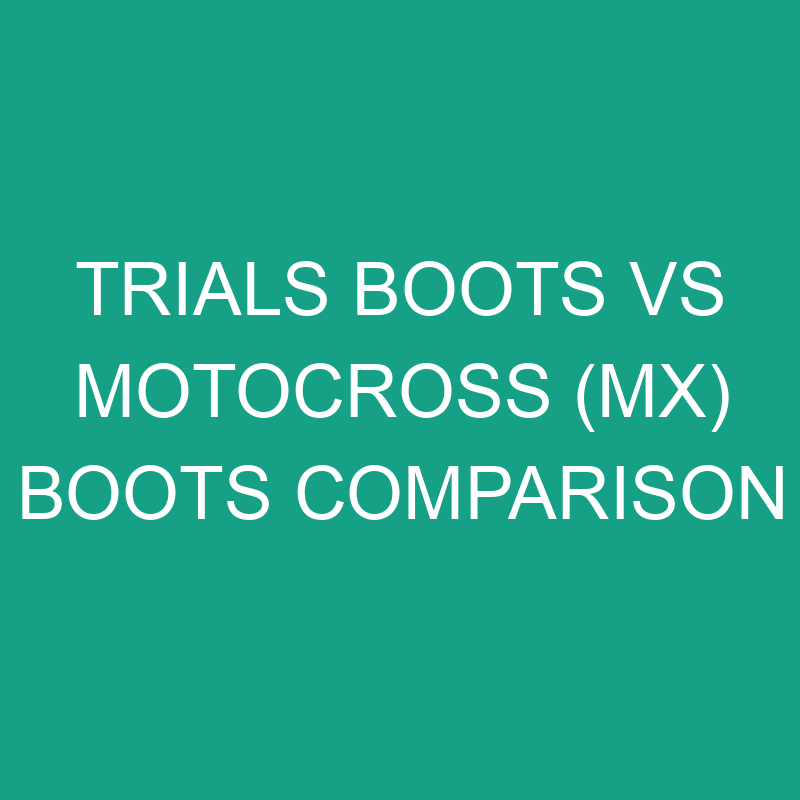Trials Boots vs. Motocross (MX) Boots: A Comprehensive Comparison for Off-Road Riding
Off-road motorcycle riding demands specialized footwear to provide riders with the protection, comfort, and control required for tackling rough terrain. Trials boots and Motocross (MX) boots are two distinct categories of riding boots designed to meet these demands. In this comprehensive comparison, we will explore the differences and similarities between trials boots and MX boots, including their design, construction, protective features, comfort, fit, pricing, and the specific riding disciplines they excel in. By the end of this article, you’ll have a clear understanding of which type of boot best suits your off-road riding needs.
Post Contents
1. Design and Purpose:
Trials Boots:
- Purpose: Trials boots are specifically designed for trials riding, a discipline where riders navigate challenging terrain with slow, precise movements.
- Low Profile: They feature a lower profile design that allows for better feel and control over the bike’s controls, particularly the rear brake.
- Sole Flexibility: Trials boots have flexible soles that enable riders to grip the bike’s frame with their legs for balance during tricky maneuvers.
- Minimalistic: Trials boots are minimalistic in design, with a focus on weight reduction and flexibility.
- Weight: They are typically lighter than MX boots, which aids in the agility required for trials riding.
MX Boots:
- Purpose: MX boots are designed for motocross and other high-speed off-road racing disciplines.
- High Shaft: They have a higher shaft that offers substantial ankle and leg protection to withstand the rigors of motocross racing.
- Stiff Sole: MX boots feature stiff soles to provide stability and protection against the impacts and forces encountered in racing.
- Bulky Construction: These boots are often bulkier compared to trials boots due to the added protection.
- Weight: MX boots tend to be heavier to provide adequate protection during high-speed racing.
2. Protective Features:
Trials Boots:
- Ankle Flexibility: Trials boots prioritize ankle flexibility to allow riders to articulate their feet and legs while maintaining balance.
- Reinforced Toe and Heel: They often have reinforced toe and heel areas to protect against impacts with rocks and obstacles.
- Minimal Shin Protection: Trials boots typically provide minimal shin protection, as trials riding involves less risk of leg injuries.
- Sole Grip: The flexible sole design enhances grip on the footpegs and the ground while walking.
- Lower Shin Plate: If present, the shin plate is smaller and less prominent compared to MX boots.
MX Boots:
- Rigid Ankle Support: MX boots offer rigid ankle support to prevent hyperextension and provide stability during high-speed jumps and landings.
- Substantial Shin Protection: They feature large shin plates to shield against roost, impacts from other riders, and debris on the track.
- Toe Box Protection: MX boots have reinforced toe boxes to safeguard against the forces generated during races.
- Calf Guards: Some models include calf guards for added protection against the heat of the bike’s exhaust.
- Sole Durability: The stiff sole construction enhances durability and provides a solid platform for controlling the bike.
3. Comfort and Fit:
Trials Boots:
- Flexibility: Trials boots offer excellent flexibility, allowing riders to feel the bike and execute precise movements.
- Comfortable for Walking: Their flexible soles make walking and maneuvering off the bike more comfortable.
- Minimal Break-In: Trials boots typically have a shorter break-in period due to their flexible design.
- Fit: They tend to have a snug fit around the ankles and mid-foot for control.
MX Boots:
- Stiffness: MX boots have a stiff and rigid design, which can limit ankle movement and require a break-in period.
- Less Comfortable for Walking: Due to their stiff soles and bulkier construction, walking in MX boots can be less comfortable.
- Enhanced Protection: The stiffness of MX boots is essential for protecting riders during high-impact scenarios.
- Fit: MX boots often feature adjustable straps and buckles for a secure and customized fit.
4. Riding Disciplines:
Trials Boots:
- Trials Riding: As the name suggests, trials boots are primarily intended for trials riding, where precise control and balance are key.
- Low-Speed Riding: They excel in low-speed, technical riding scenarios that demand agility and control over outright speed.
MX Boots:
- Motocross Racing: MX boots are tailored for motocross and other high-speed off-road racing disciplines.
- High-Speed Riding: They are ideal for high-speed, aggressive riding where protection against impacts and roost is crucial.
5. Pricing:
Trials Boots:
- Varied Pricing: Trials boots are available in a range of price points, with more advanced features and materials commanding higher prices.
- Affordability: Entry-level trials boots can be relatively affordable compared to high-end MX boots.
MX Boots:
- Mid to High-End Pricing: MX boots are often priced in the mid to high-end range due to their advanced protective features and materials.
- Investment: High-quality MX boots are considered an investment in rider safety and performance.
6. Conclusion:
In conclusion, choosing between trials boots and MX boots depends on your specific off-road riding style and preferences:
- Choose Trials Boots if:
- You primarily engage in trials riding, where precise control and balance are paramount.
- You value lightweight, flexible boots that allow for ankle articulation.
- You want boots that are comfortable for both riding and walking.
- Choose MX Boots if:
- You participate in motocross racing or high-speed off-road disciplines that involve substantial impacts and roost.
- You prioritize ankle and leg protection, even if it means sacrificing some flexibility.
- You are willing to invest in boots designed for the rigors of high-speed racing.
Ultimately, both types of boots serve their specific purposes exceptionally well and enhance rider safety and performance in their respective riding disciplines.
